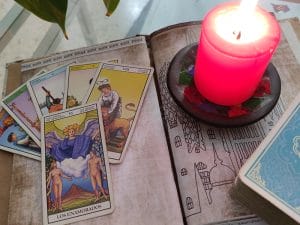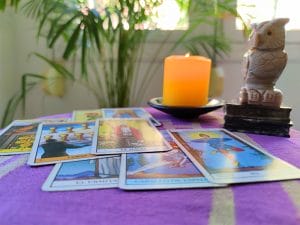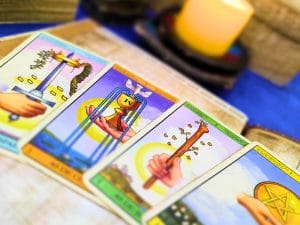The number 8 and its relevance in tarot
The number 8 and its meaning in the four suits of the deck
General aspects of the number 8
The number 8 is very diverse, similar across the 4 suits that make up the Minor Arcana in tarot. They contain the solid essence of the four, but without their enclosing walls, without the fear.
The eights are just about to go beyond that structure, yet still operate within its rules. They take the lessons of growth from all the numbers before them and move even higher, still striving for something different and improved.
There’s no hint of new beginnings in the eights, but in a way, it’s an attempt to reach a new beginning. Doing now what needs to be done to move to a higher stage.
It’s the certainty that the old ways don’t work as well as you’d hoped. The eights embody both building and destruction, but in an internal, mental, intellectual way.
It’s not the destruction of the Tower, nor the radical change of Death, though both are present in a more subtle way, which can make it hard to grasp the essential meaning of the card sometimes.
The eight is a number beyond perfection, representing infinity. The mathematical symbol of infinity, the lemniscate, is, after all, the number eight lying on its side, horizontal. We see this symbol in several tarot cards: It appears in the Magician, the Two of Pentacles, and, notably, with a positive meaning, in the Major Arcana card Strength, which is number VIII. This card aligns clearly with the symbolism of the number eight, offering a multifaceted approach to challenges.
The eight is the number of balance and cosmic order in the universe, according to the Egyptians. In Mesopotamia, the eight-petaled rosette was also the emblem of the fertility goddess Ishtar and her planet Venus.
This symbolizes the basic meaning of birth, death, and rebirth, or construction and destruction, leading to a new aspect. For early Christians, it was the symbol of new life, the final resurrection, and the anticipated resurrection that is baptism.
It was also the number of the Beatitudes (the Blessed) in the Sermon on the Mount. The number eight as a symbol of a new beginning is seen in the Bible, as when Noah saved eight people from the flood to start anew.
Similarly, the Jewish rite of circumcision, marking the newborn’s relationship with God, takes place on the eighth day, and in Leviticus 9:1, the inauguration of the Tabernacle, as the new dwelling of God’s presence, occurred after seven days of preparation, on the eighth day.
In Jewish Kabbalah, the number corresponds to the eighth Sephira, Hod or “Splendor”. The Star of Bethlehem is usually depicted with eight rays.
Also, Easter Sunday, the day Christ is said to have risen from the dead, is counted as the eighth day after Palm Sunday, the day Jesus entered Jerusalem. I know it seems like seven days to us, but the ancients had an inclusive way of counting the day itself plus the following days.
Eight is a greater representation of four, and also represents the Earth, not on its surface, but in its volume, as eight is the first cubic number.
The Pythagoreans made the number eight a symbol of love, friendship, prudence, and thought, and they called it the Great “Tetrachtys”.
The eight-spoked wheel, or Dharmachakra, symbolizes the Buddha turning the Wheel of Truth or Law (dharma = truth/law, chakra = wheel). The Dharmachakra has eight spokes, which symbolize the Noble Eightfold Path. In neopaganism, there are eight Sabbats, festivals, seasons, or spokes on the Wheel of the Year. Eight solar years are also the time it takes for the “new” winter solstice sun to return close to a new moon.
In China, the number eight expresses the totality of the universe. Eight is considered an auspicious number for the Chinese not only because it sounds like “prosper” or “fa” in Cantonese. Therefore, eights represent potential for growth: a shift from bad luck to good fortune.
The Eight is also synonymous with the eight trigrams (Bagua) – a symbol of good fortune and transformation. Across many cultures and ideologies, the number eight seems to carry a similar meaning: movement from less to more, destruction, regeneration, and resurrection—a kind of microcosm or life cycle of its own.
In numerology, eight is the number of building, and in some theories, also the number of destruction. The eighth has the primary numerological meanings of wholeness, change, leadership, and power, and is considered one of the strongest numbers in certain schools of numerology.
The focus of the eight is on material possessions and money, and it’s very powerful for attracting wealth. However, when eight appears in your numerology reading, you tend to experience great gains and losses, representing big ups and downs, which also aligns with the somewhat contradictory meaning of eight. Lots of cycles.
Ruled by Saturn, number eight people experience both pain and success. If you’re an eight person, you possess great willpower and individuality, which is often misunderstood, partly because you hide your strong feelings beneath a cool exterior. Sounds a bit like Scorpio, the eighth astrological zodiac sign.
The number 8 in the Major Arcana
 Now, let’s return to Major Arcana VIII, Strength: Often referred to as Strength or Fortitude, one of the four cardinal virtues in tarot.
Now, let’s return to Major Arcana VIII, Strength: Often referred to as Strength or Fortitude, one of the four cardinal virtues in tarot.
Some earlier depictions of this card show brute strength, while others (like our Rider-Waite deck) show a woman (Virtues are often symbolized by women) breaking a pillar or closing the mouth of a lion.
To the ancient Greeks, strength meant bringing all your resources to bear in a situation, doing whatever is necessary to overcome the challenge, even if that means using quiet force or facing the problem aggressively and head-on. Different approaches may be required depending on the situation.
Today, tarot readers often default to the meaning of overcoming one’s inner impulses, and while that can be one interpretation of strength, it’s not the only one, and is more applicable to temperance.
In some cases, grabbing the bull by the horns, the tiger by the tail, or, in this case, the lion by the jaws is exactly what’s required— a certain internal and aggressive strength, and once you’ve got it, you can’t let go until the job is done.
This type of challenge demands determination and strength, and once you’ve made it through with this force, you often come out the other side a very different person, hence the rebirth aspect of the eight.
The person may not come out unscathed, and in fact, is likely to suffer some deep cuts from those sharp teeth and claws, so the theme of suffering and success is evident in the card.
The infinity symbol is seen above the woman’s head in the Rider-Waite version of the card, implying the refining of one’s inner strength through challenge and perhaps biting off more than you think you can chew.
The number 8 in the Minor Arcana
The 8 of Swords
 The Eight of Swords is one of those scenic cards that makes you wince a little. Typically, it depicts a blindfolded person, barefoot, surrounded by eight swords.
The Eight of Swords is one of those scenic cards that makes you wince a little. Typically, it depicts a blindfolded person, barefoot, surrounded by eight swords.
Often, when someone gets this card in a reading, they don’t immediately relate to the feeling of being trapped and unable to figure out the way forward to free themselves.
This is, like all eights, a challenge that needs to be faced and overcome, following the message of Strength. However, since it’s from the suit of Swords, this is a mental challenge, one that requires using your intellectual faculties to break free from the situation, and as an eight, it probably involves a bit of both.
Something must be destroyed in order to gain freedom, and in this case, it’s necessary to cut the ties, to abandon a certain mindset that got you into this sticky situation in the first place. You have to rely on your inner resources (again, Strength) instead of sight and a problematic thinking pattern, carefully feeling the ground with your bare feet for clues about your next move.
The desolate landscape and circular arrangement of swords suggest that this situation could literally go on forever (the infinite nature of eight), unless the person does something about it themselves.
The 8 of Cups
 The Eight of Cups shows another desolate setting, a place of darkness and stagnant waters. The symbolism of this eight is more tied to the aspect of regeneration, and inner strength as well.
The Eight of Cups shows another desolate setting, a place of darkness and stagnant waters. The symbolism of this eight is more tied to the aspect of regeneration, and inner strength as well.
The person is usually seen leaving behind eight cups, which represent emotional ties, relationships, and other significant associations, in order to pursue what they feel most emotionally connected to.
In reference to the Sevens, and their tempting cups offering various choices, now this person has decided which cup contains their most desired wish, and in the Eights, they leave the others behind to go after that dream.
This could be one of the hardest decisions one makes in life, and it therefore requires the inner strength and determination of the VIII to follow through. The lesson of the eights is that nothing good comes without sacrifice and suffering, which is sometimes just part of the journey toward success.
We must face the bitter with the sweet. However, something in the Eight of Cups compels us to move beyond what we’ve known and loved, toward something more, something we believe is out there, even if we don’t yet know what that something is going to be.
The 8 of Wands
 The Eight of Wands is more focused on the power of the eights to get things done as quickly as possible. It’s often a card that primarily shows eight wands, without any added scenery to tell the story.
The Eight of Wands is more focused on the power of the eights to get things done as quickly as possible. It’s often a card that primarily shows eight wands, without any added scenery to tell the story.
In the Thoth deck design, it’s called “Swiftness,” and the keyword is very fitting for the energetic eights in this card. This is the “get it done” card, taking the aspect of Strength and implying you should face a challenge head-on and move quickly toward its resolution.
In modern terms, this card has come to represent the rapid communication frequency of the internet, emails, and text messages, conveying information back and forth in the blink of an eye.
However, it can also represent various actions happening at once with a common goal. To coordinate these efforts, a good deal of focus and determination is needed to make sure all eight wands hit the intended target.
This highlights the facet of eight that relates to multiplicity, balance, and order. While the wands aren’t yet nailed down to their goal, they’re not flying in fifty different directions either. They’re going in a specific order, in unison. They’ve been aimed and are aligned with one another, so there’s purpose and direction in their flight. Events will happen quickly, and there’s a focused purpose behind them.
The 8 of Pentacles
 The Eight of Pentacles is built on inner determination that’s applied to a task requiring detailed focus, extended over a period of time.
The Eight of Pentacles is built on inner determination that’s applied to a task requiring detailed focus, extended over a period of time.
This card often shows an apprentice at work, hammering out a series of pentacles in what appears to be an assembly line. This kind of detailed work requires dedication, the type of work that stretches beyond the usual day and time frame, and it might mean working late into the night.
Often, when you see this card, you can feel the intensity of the young person’s concentration. They’re fully absorbed in what they’re doing and are truly determined to get it just right, no matter how long it takes.
It also reflects the aspect of eights that represents building, as they’re building their reputation and honing their skills. The alignment of the completed pentacles shows the order of the eights, and also the idea that to reach the highest levels, you must start from the bottom.
Some find this card slightly out of order in the sequence of the suit of Pentacles, and some decks, like Hudes, have changed the meanings of the Three and the Eight, showing an apprentice in the Three and a master in the Eight.
But I believe this is incorrect when you consider the loss that occurred in the Five and the decision-making of the Seven. Here, you have someone starting over, but not from scratch.
They’re learning a new skill that builds upon the skills they’ve already acquired. They’re taking on a new field of activity, and as such, they’re expanding their resume.
Perhaps they’ve found an area of their work in which they’ve never excelled, and they’re polishing their skills in that area so they can be even better at what they do.
This is the person from the Seven who dreamed of what they wanted, and now they’re setting out to achieve that goal. They’re doing what needs to be done, even if it seems a bit boring or repetitive.
A quick conclusion
The eights are a mixed bag, to be sure, and what really helps tie the cards back to Strength is understanding the different types of approaches and the various facets of strength itself.
If you understand Strength, you’ll understand the eights. Some situations require a slow, tedious, dedicated approach, while others demand you tackle the issue head-on.
Some situations force us to hold back and slow down, while others require us to muster the courage to act decisively and with vigor. The four Minor Arcana show these different approaches, with the cyclical and dual idea of building and destruction, suffering and success, that the eights represent.
Dejame tus Comentarios AQUI
Colabora con el mantenimiento del Blog
Si encuentras que mis contenidos te han sido de utilidad, los consultas con frecuencia y quieres agradecer y colaborar con el mantenimiento de la web para seguir mejorando, puedes hacerlo a través de una donación. Aunque mínima, será de gran ayuda para seguir en línea.
Más contenidos interesantes...
Pídeme tu Lectura

3 Preguntas
¿Tienes preguntas especificas? Aquí puedes realizar hasta 3 preguntas de un mismo tenor o de diferentes temas

¿Debo continuar?
¿Te encuentras en la disyuntiva si debes continuar con tu pareja o no? Esta es tu lectura

Mi futuro general
¿Qué te depara el futuro a corto plazo? ¿Qué puedes esperar de los próximos 1 a 6 meses?









